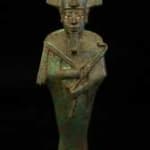26th Dynasty Bronze Osiris with Inlaid Electrum Eyes, 664 BCE - 525 BCE
Bronz and Electrum
height 15.9 cm
height 6 1/4 in
height 6 1/4 in
X.0462
Further images
-
(View a larger image of thumbnail 1
)

-
(View a larger image of thumbnail 2
)

-
(View a larger image of thumbnail 3
)

-
(View a larger image of thumbnail 4
)

-
(View a larger image of thumbnail 5
)

-
(View a larger image of thumbnail 6
)

-
(View a larger image of thumbnail 7
)

-
(View a larger image of thumbnail 8
)

-
(View a larger image of thumbnail 9
)

This magnificent bronze votive sculpture represents Osiris, god of fertility, king of the dead, and ruler of eternity. Many centuries ago, it might have been found inside a temple, placed...
This magnificent bronze votive sculpture represents Osiris, god of fertility, king of the dead, and ruler of eternity. Many centuries ago, it might have been found inside a temple, placed as an offering to the mighty deity. He is depicted wrapped as a mummy, holding a crook and flail. These two attributes act as scepters symbolic of his divine authority over the forces of nature. He wears the atef crown, featuring a Uraeus cobra slithering down the front and a false braided beard with a curved tip. This type of beard is a symbol of divinity while the headdress associates the god with the ruling pharaohs. On the back, a falcon head symbolic of Horus is present. The falcon wears a tripartite wig and is crowned with a double plumed headdress replete with a solar disk and Uraeus cobra. Furthermore, an incised decorative band leads just below the falcon head on his shoulders to the back of his feet. This design appears to imitate colorful beaded necklaces that have been found decorating mummies from this period. This sculpture is in a remarkable state of preservation; even the inlaid electrum eyes have survived intact. The legend of Osiris states that his brother Seth, overcome by jealousy, murdered him and tore his body into fourteen parts, scattering them across Egypt. Isis, the faithful wife of Osiris, traversed the land and gathered all the parts of his body. She then cast a spell that resurrected her deceased husband for one night, during which their child, Horus, was conceived. Thus, Osiris was the central figure of Egyptian religion, the god who had triumphed over death and therefore offered the hope of rebirth and resurrection to all men. This striking image of the god in his royal mummiform speaks of a universal mystery, the unanswered questions for which no living man has a sure answer.








